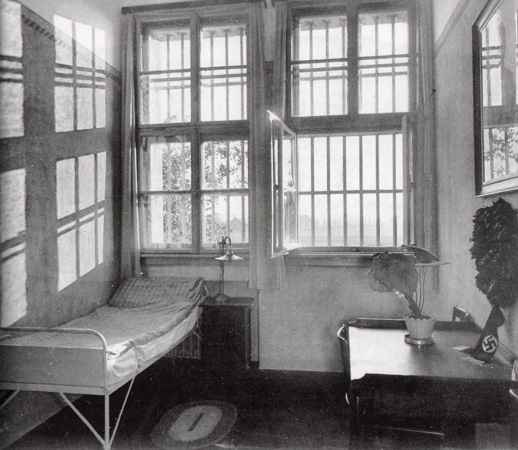The Trial of Adolf Hitler: A Chronology

Adolf Hitler's cell at Landsberg Prison.
April 20, 1889 Adolf Hitler is born in Braunau Am Inn, Austria.
1907 Hitler moves to Vienna with the aim of attending the Vienna Academy of Art. His application is rejected.
1914-1918 Hitler serves in WW I, mainly as a dispatch runner.
1919 Hitler is appointed to the Intelligence/Propaganda section of the German army, where he receives political training and is assigned the task of making speeches to the troops advocating German nationalism. Hitler joins the German Workers Party.
1920 Hitler changes the name (and, to some extent) the focus of the German Workers Party and it becomes the National Socialist German Workers' Party, or Nazi Party for short.
February 20, 1920 Hitler Delivers his "Twenty-Five Theses" Speech, laying out the program of the Nazi Party, at the Munich Hofbräuhaus.
July 29, 1921 Hitler is named as the Führer of the Nazi Party.
Nov. 8, 1923 (11:30) Hitler announces to other key figures in the Nazi Party that the putsch will happen tonight at the Burgerbraukeller (“the beer hall”) tonight.
Nov. 8 (6:00) The SA (Storm Troopers) carrying the swastika flag, march in Munich’s streets.
Nov. 8 (7:00) The shock-troop (or bodyguard) unit of the Nazi Party assemble in a bowling alley, receive guns and grenades, and are told they will arrive at the beer hall by 8:30.
Nov. 8 (7:30) Generalkommissar Gustav von Kahri is introduced as a speaker for the night’s political rally at the beer hall.
Nov. 8 (8:00) Hitler and his bodyguard arrive at the beer hall.
Nov. 8 (8:34) Hitler jumps on a table in the banquet hall, fires two shots at the ceiling, pushes his way on to the stage, and announces, “the National Revolution has begun!”
Nov. 8 (8:45) Hitler, at gunpoint, takes three Bavarian leaders (Kahr, Lossow, and Seisser) into an adjoining room with the hope of convincing them to join his revolution.
Nov. 8 (9:30) Hitler, General Ludendorff (an earlier recruit to the revolution) and the three Bavarian leaders take the stage in the banquet hall. The men announce they have agreed to form a provisional government.
Nov. 8 (10:30) Hitler leaves the beer hall to intercede in a situation at barracks where an attempted Nazi takeover had reached a stalemate.
Nov. 8 (11:30) The crowd begins to leave the beer hall, although 60 to 70 Jews are roughed up and detained. Ludendorff allows the three Bavarian leaders to leave the hall and “occupy their posts.”
Nov. 9 (early am ) The three released Bavarian leaders begin planning their counter-putsch.
Nov. 9 (2:55am): The three Bavarian leaders issue an announcement on Munich radio stations repudiating the Hitler putsch.
Nov. 9 (9:30am) Hitler, now back at the beer hall, is interviewed by a group of foreign journalists.
Nov. 9 (11:00an) 2 to 3,000 Nazi-supporting troops surround the beer hall.
Nov. 9 (11:30am) Hitler and Ludendorff announce they will lead a march to the center of Munich, hoping that the march will produce a groundswell of public support and allow the revolution to succeed.
Nov. 9 (11:45am) At the War Ministry, where Nazi troops are besieged, shots are fired and two men die.
Nov. 9 (noon) The marchers leave the beer hall and head towards the center of Munich.
Nov 9 (12:30) Gunfire breaks out netween the putsch army and Bavarian State Police as the marchers approach the Odeonplatz, a large public square in Munich. Twenty men, including four members of the state police, are killed. Hitler suffers a dislocated shoulder, but manages to flee.
Nov. 9 (3:00) By now, the Jewish hostages at the beer hall have been released, the Nazi troops at the War Ministry have surrendered, and Lossow declared that “the putsch has been broken.”
No. 9 (4:00) Hitler arrives at a villa in the village of Uffing, where he will hide until his capture.
Nov. 11, 1923 Hitler is arrested on charges of high treason and taken to Landsberg Prison.
Nov. 13, 1923 Hitler is interviewed in prison by Hans Ehard, who will be the chief prosecutor in the upcoming trial.
Nov. 14, 1923 Hitler begins a hunger strike that will last for over a week.
Jan 8, 1924 Hitler is found fit to stand trial.
Feb. 16, 1924 Kahr resigns at general commissioner of Bavaria.
Feb. 24, 1924 The trial of Adolf Hitler and nine other putschists opens at the Munich Infantry School.
Feb. 26, 1924 Hitler gives a four-hour opening speech explaining his political views and goals.
March 27, 1924 On the last day of trial, the defendants give closing addresses. Hitler’s speech is powerful--and effective in gaining public sympathy.
April 1, 1924 Judge Neithardt announces the verdicts. Hitler is found guilty, but receives only a lenient 8-month sentence. Under a strained interpretation of the law, he is not banished even though that is generally part of the punishment for non-German citizens convicted of high treason.
May 1924 Hitler begins writing Mein Kampf.
Dec. 19, 1924 The Bavarian Supreme Court grants Hitler parole.
Dec. 20, 1924 Hitler is released from Landsberg Prison.
1925 Hitler re-founds the Nazi party.
Sept. 1930 The Nazi Party increases its representatives in parliament and Hitler becomes the leader of the second largest party in Germany.
1932 Hitler becomes a German citizen.
January 1933 Hitler becomes chancellor of a coalition government.
